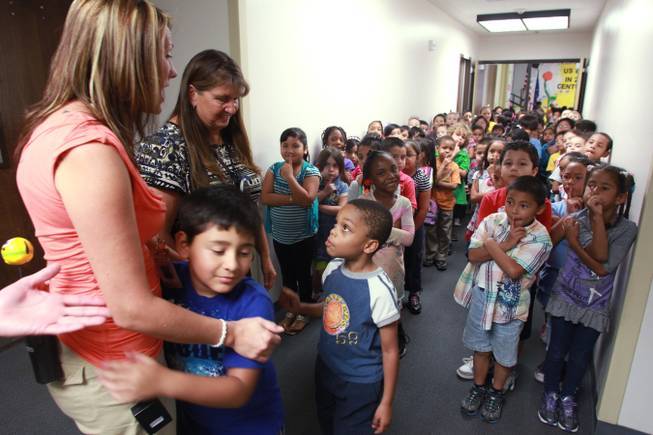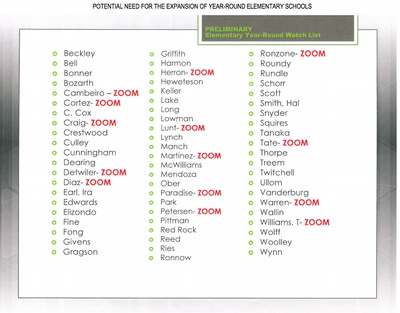
Sam Morris / Las Vegas Sun
Children line the hallway after eating lunch at Mendoza Elementary School on Wednesday, Sept. 26, 2012.
Published Wednesday, Sept. 4, 2013 | 11:49 a.m.
Updated Wednesday, Sept. 4, 2013 | 5:06 p.m.
Elementary School Crowding
Although Clark County elementary schools are bulging at the seams, its middle and high schools are currently under capacity.
That will likely change however as elementary schoolchildren graduate onto higher grade levels.
Here are the projected student enrollment figures, according to the Clark County School District:
- Elementary Schools: 147,951 total students; 15,201 students or 11.4 percent over capacity.
- Middle Schools: 71,934 total students; 10,315, or 12.5 percent under capacity.
- High Schools: 90,088 total students; 2,743, or 3 percent under capacity.
The Clark County School District is considering expanding year-round schedules next year to 65 more elementary schools to alleviate student crowding.
As the economy rebounds, the School District – the fifth largest in the nation – is expecting an influx of students from new housing developments. This year, the district estimates it will have 1,500 more pupils than 2012-'13, likely pushing enrollment to a record 313,000 students.
In the past, the School District – flush with property tax receipts – was able to build new schools to accommodate its student enrollment growth. Since 1998, Clark County has built more than 100 new schools, becoming at one point the fastest-growing school system in the country.
However, the economic downturn changed all that. The School District doesn’t have the capital funds to adequately maintain the schools it has, let alone build new schools.
Although the district has identified $669 million in immediate facility needs, it only has $44 million in capital money remaining from its last bond program, issued 15 years ago.
“It’s pretty bleak,” School Board member Linda Young said at a board workshop this morning. “We’re in a crisis, a real crisis.”
In November 2012, the School District sought voter approval for a tax initiative that would have generated up to $720 million over six years to fund high-priority renovations and technology upgrades at 40 of the district's oldest and most dilapidated schools.
The capital program also would have funded construction of two new elementary schools to alleviate crowding in the southwest valley, and the replacement of aging Lincoln and Rex Bell elementary schools.
However, voters overwhelmingly rejected the ballot measure, known as Question 2, by a margin of two-to-one. Even the precincts that would have benefited from school upgrades voted against the measure, which district officials acknowledged was rushed and poorly explained to the public.
“It was the most resounding defeat we have ever seen,” Associate Superintendent Joyce Haldeman said.
Without money to build schools, the School District has only a handful of choices, all difficult for School Board members to make and for families to swallow.
"It's not a punishment. It's just a reality of life," School Board member Deanna Wright said. "It frustrates me because we did try to tell people (about Question 2) and they weren't listening so now we have to go into crisis mode."
There’s the nuclear option: Districtwide rezoning that would affect thousands of students. Under this option, attendance zones would be redrawn to even out student enrollments at all 357 schools, but it could tear apart childhood friendships and established school communities.
Only two School Board members – Deanna Wright and Linda Young – expressed mild support for the option, which they described as inevitable.
The other, more palatable option is to create more year-round schools. Although doing so would disrupt summer vacation plans for some families and create scheduling headaches, it’s preferred to large-scale rezoning, according to School Board and community members. It also benefits students at risk of falling behind over the summer vacation, particularly English-language learners.
"If we're going to be competitive and help our young people, we've got to look at year-round, but also more school days and longer school days and Saturday (classes)," Young said. "We lose a lot during the summer."
This fall, after a two-year hiatus to save the district more than $20 million annually, the School District brought back year-round schedules to three southwest valley elementary schools: Forbuss, Reedom and Wright.
Students attending these schools, each of which had more than 1,200 students last year, are now on different “tracks,” attending schools at different times throughout the year to ease crowding.
Next year, up to 65 more schools may go year-round, according to a proposal announced today. The district released a list of 65 schools, including 14 “Zoom” schools for English-language learner students, that could go year-round in the 2014-15 academic year.
The 65 schools are candidates for year-round schedules because their enrollments are 25 percent above building capacity and they have more than eight portable classrooms. Some of the 65 are projected to have even higher enrollments next year.
Although year-round scheduling can lower student enrollment by 20 percent at any given time, going year-round comes at an additional cost: $300,000 per school – above the costs for operating a school on a nine-month schedule, according to the district.
If all 65 schools on the list were to go year-round, the School District is looking at a cost of $19.5 million.
It’s cheaper than building a new elementary school, which comes at a cost of about $25 million. However, it’s a temporary solution that only puts more wear and tear on school buildings.
Unless the School District can come up with more money to build new schools and repair the ones it has, the district will continue to face issues of student crowding and facilities problems, like broken air-conditioning systems that closed two high schools this week.
“It’s going to be a major challenge to keep schools open and running,” Superintendent Pat Skorkowsky said.
Consequently, the School Board is mulling another big ask of voters: approve a capital program to raise money for new schools and building renovations.
Over the next several months, School Board members will consider several options to raise capital funds, including a property tax increase like Question 2 or debt restructuring that could free up the district’s capacity to issue more bonds.
A ballot initiative could go before voters as early as 2014, where it would face stiff competition from other initiatives, such as the 2 percent margins tax on businesses, backed by the teachers union, and a bond program that would benefit the Regional Transportation Commission.
The district may find more success in waiting until 2016.
“It’s clear we have needs,” School Board President Carolyn Edwards said. “Whether we can be successful in 2014, I don’t know.”
Regardless of what kind of capital program it chooses, the School Board acknowledged it would take a lot of persuading to convince the public to approve more money for schools.
“We’ve got to come up with a plan for people who are retired, people who do not have children, to be willing to invest in our schools and help generate some capital,” Young said. “We’re going to have to do a massive campaign to get each person to look at our situation as dire. We’re sinking fast.”


Join the Discussion:
Check this out for a full explanation of our conversion to the LiveFyre commenting system and instructions on how to sign up for an account.
Full comments policy